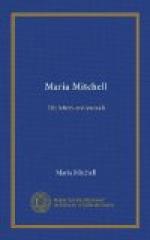“I asked him if Babbage was in the room, and he too said, ‘Not yet.’ Dr. Arnott asked me if I wore as many stockings when I was observing as the Herschels—he said Sir William put on twelve pairs and Caroline fourteen!
“I stayed until eleven o’clock, then I said ‘Good-by,’ and just as I stepped upon the threshold of the drawing-room to go out, a broad old man stepped upon it, and the servant announced ‘Mr. Babbage,’ and of course that glimpse was all I shall ever have!
“Edinboro’, September 30. The people of Edinboro’, having a passion for Grecian architecture, and being very proud of the Athenian character of their city, seek to increase the resemblance by imitations of ancient buildings.
“Grecian pillars are seen on Calton Hill in great numbers, and the observatory would delight an old Greek; its four fronts are adorned by Grecian pillars, and it is indeed beautiful as a structure; but the Greeks did not build their temples for astronomical observations; they probably adapted their architecture to their needs.
“This beautiful building was erected by an association of gentlemen, who raised a good deal of money, but, of course, not enough. They built the Grecian temple, but they could not supply it with priests.
“About a hundred years ago Colin Maclaurin had laid the foundation of an observatory, and the curious Gothic building, which still stands, is the first germ. We laugh now at the narrow ideas of those days, which seemed to consider an observatory a lookout only; but the first step in a work is a great step—the others are easily taken. There was added to the building of Maclaurin a very small transit room, and then the present edifice followed.
“When the builders of the observatory found that they could not support it, they presented it to the British government; so that it is now a government child, but it is not petted, like the first-born of Greenwich.
“There are three instruments; an excellent transit instrument of six and a half inches’ aperture, resting on its y’s of solid granite. The corrections of the errors of the instrument by means of little screws are given up, and the errors which are known to exist are corrected in the computations.
“Professor Smyth finds that although the two pillars upon which the instrument rests were cut from the same quarry, they are unequally affected by changes of temperature; so that the variation of the azimuth error, though slight, is irregular.
“The collimation plate they correct with the micrometer, so that they consider some position-reading of the micrometer-head the zero point, and correct that for the error, which they determine by reflection in a trough of mercury. With this instrument they observe on certain stars of the British Catalogue, whose places are not very well determined, and with a mural circle of smaller power they determine declinations.
“The observatory possesses an equatorial telescope, but it is of mixed composition. The object glass was given by Dr. Lee, the eye-pieces by some one else, and the two are put together in a case, and used by Professor Smyth for looking at the craters in the moon; of these he has made fine drawings, and has published them in color prints.




